Have you ever spent hours writing a blog post, carefully choosing the best keywords like ‘apple’ to boost your ranking, only to see your content still end up on page three of Google? Frustrating, right? That’s because search engines have evolved, and your SEO strategy needs an upgrade.
This is where Semantic SEO comes in, a smarter approach that focuses on meaning, context, and what users really want, rather than just stuffing in keywords. In this guide, you’ll learn how to make your content more relevant and authoritative using Semantic SEO. This means better rankings and stronger connections with your audience.
Ready to boost your SEO? Let’s get started!
Table of Contents
What is Semantic SEO?
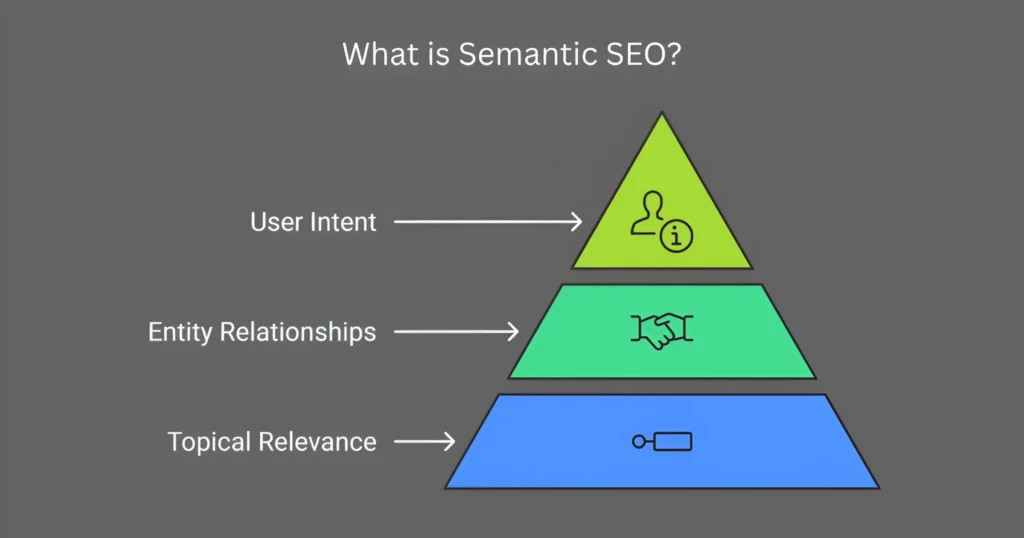
Semantic SEO is optimizing content so search engines understand the meaning behind your words, not just the keywords. It focuses on:
- Topical Relevance: Covering every subtopic in that topic.
- Entity Relationships: Connecting related concepts (e.g., Apple as a fruit vs Apple as a company)
- User Intent: Answering what users are truly searching for.
Example: Instead of targeting “apple” as a keyword, you’d write about related topics like “apple health benefits” or “how to cook with apples.”
Why is Semantic SEO Important?

Semantic SEO offers several advantages:
- Improved User Experience: It answers real questions users have.
- Better Rankings: Search engines reward content that fully covers a topic.
- Higher Engagement: Readers spend more time on pages that meet their needs thoroughly.
How Does Semantic SEO Work?
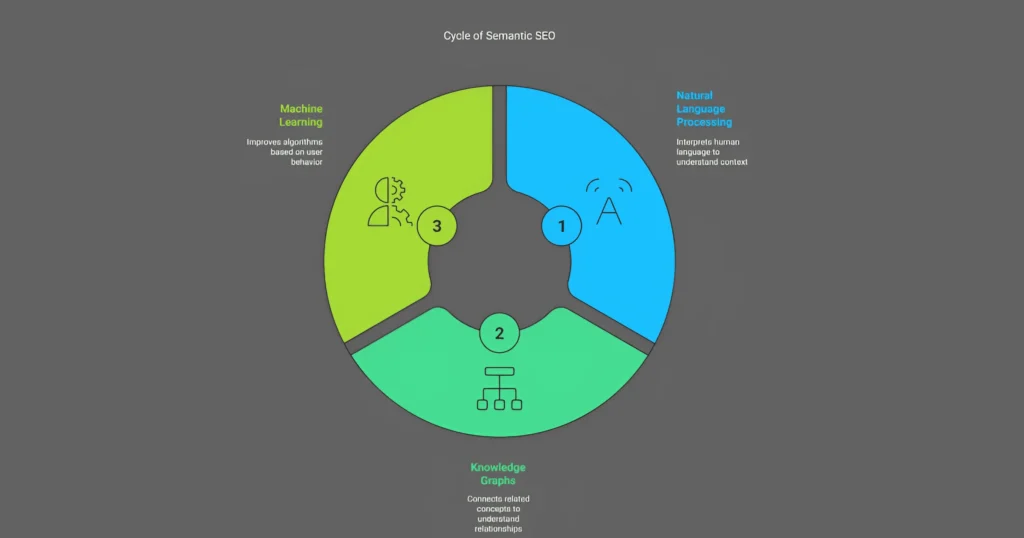
Semantic SEO relies on advanced technologies to understand the meaning and context of your content. Here’s how it works:
1. Natural Language Processing (NLP)
Search engines use NLP to interpret human language and understand the context of queries. For example, Google knows that “tips for training a puppy” means advice about dog training for young dogs. Not just matching exact keywords.
2. Knowledge Graphs & Entities
Google connects related concepts (entities) like people, places, and things through its Knowledge Graph. This helps search engines understand relationships between topics.
3. Machine Learning
Search engines continuously improve their algorithms through machine learning, adapting to user behavior and delivering better results.
How to Master Semantic SEO
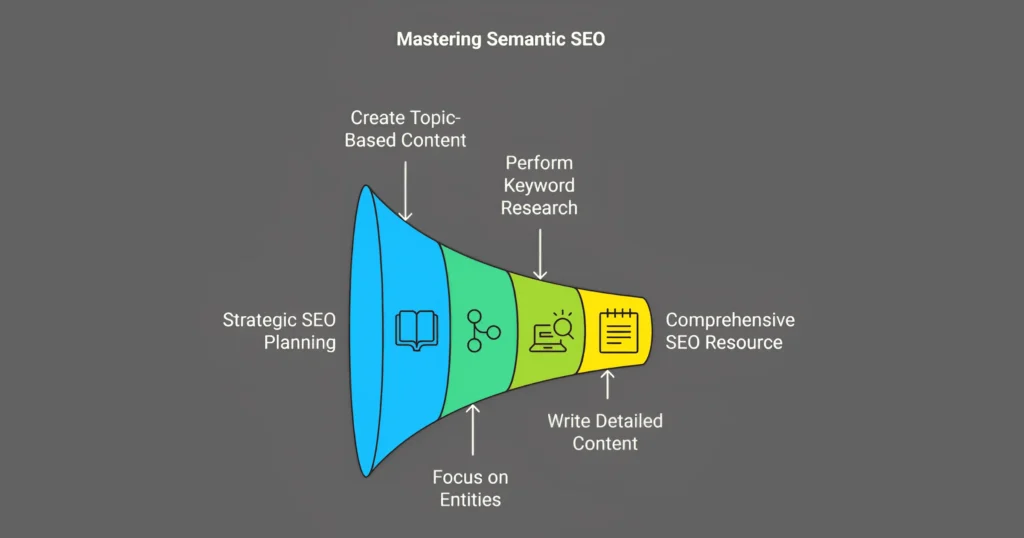
Mastering semantic SEO involves strategic planning and execution. Here’s how you can adapt it:
1. Create Topic-Based Content
Organize your blog around comprehensive topics instead of single keywords. Use pillar pages to cover broad subjects and link them to detailed subtopics.
2. Think in Entities
Focus on entities (concepts, people, places) rather than just keywords. For example:
- Topic: Coffee
- Related entities: Brewing methods, coffee regions, flavor profiles.
3. Perform Semantic Keyword Research
Use tools like Google’s “People Also Ask,” AnswerThePublic, or ChatGPT to find related terms and questions users are searching for.
4. Write Detailed Content
Cover all aspects of your topic in-depth to become the go-to resource for readers. Answer FAQs and address every subtopic related to your central theme.
How to Learn Semantic SEO
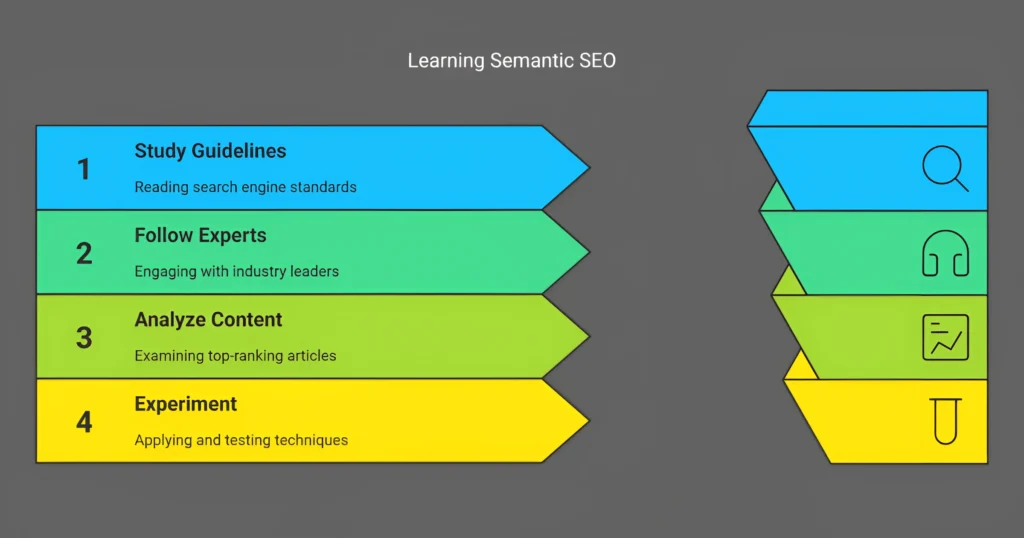
Learning semantic SEO requires both theoretical knowledge and practical application:
1. Study Search Engine Guidelines
Read Google’s Search Quality Evaluator Guidelines to understand what search engines look for in high-quality content.
2. Follow Industry Experts
Follow blogs, podcasts, and YouTube channels from top SEO professionals who specialize in semantic search.
3. Analyze Top-Ranking Content
Analyze the top 2-3 ranking articles for your target keyword. Please pay close attention to their content structure, the topics they cover, and the keywords they use. Use tools like Semrush or Ahrefs to uncover the keywords for which they’re ranking. By understanding what makes these pages successful, you can craft content that not only competes but stands out.
4. Experiment with Your Content
Apply semantic SEO techniques to your blog posts and measure results using metrics like engagement (time on page) and bounce rate.
How to Do Semantic SEO (Step-by-Step)

Here’s a practical guide on implementing semantic SEO on your blog post:
Step 1: Understand Your Topic and User Intent
Identify Your Topic: Start with a subject that your audience cares about, like “Indoor Plant Care” or “Vegan Recipes.”
Analyze Search Intent:
- Figure out whether users are looking for information, navigating to a page, making a purchase, or researching a product.
- Use tools like Google’s “People Also Ask” or “AnswerThePublic” to find common questions and related search phrases.
Step 2: Create a Detailed Content Outline
Outline Core Concepts and Subtopics:
- Break your topic into clear sections, like “Watering Tips” and “Best Light Conditions” for indoor plant care.
- Naturally include related questions, synonyms, and keyword variations throughout your outline.
Plan Topic Clusters:
- Consider creating a pillar page that links to related subtopics, helping to build a strong semantic connection between your content pieces.
Step 3: Use Semantic Keywords Naturally
Integrate Keywords:
- Focus on using keywords naturally rather than stuffing them into your content.
- Use synonyms and related terms to capture the broader context of your topic.
Group Keywords:
- Main Keywords: Primary focus (e.g., “graphic card”)
- Related Terms: Variations like “Best graphic card for gaming” or “Graphic card drivers”
- Questions: Common queries like “How do I update graphic card drivers?”
Step 4: Enhance Your Content with Structured Data
Add Schema Markup:
Use structured data like FAQ or Article schema to help search engines understand your content.
Example Schema Snippet:
<script type="application/ld+json">
{
"@context": "https://schema.org",
"@type": "Article",
"headline": "How to Write a Semantic SEO Blog Post with AI",
"description": "Learn how free AI tools can help you create optimized blog posts that rank higher in semantic search results."
}
</script>Optimize Visual Elements:
- Add clear alt text and descriptive captions to images, reflecting both the content and relevant keywords.
Step 5: Write, Publish, and Monitor Your Content
Develop Your Blog Post:
- Use clear headings (like H2s and H3s) to break your content into easy-to-read sections.
- Make sure your content covers all the subtopics related to your topic and directly answers common user questions.
Publish and Track Performance:
- Use Google Search Console to track impressions, clicks, and user engagement.
- Keep your content fresh by updating it with trending questions and new insights regularly.
Semantic SEO vs Traditional SEO
| Aspect | Traditional SEO | Semantic SEO |
|---|---|---|
| Content Focus | Keyword-based | Topic-based |
| Primary Goal | Optimized for search engines | Optimized for user intent |
| User Experience | Often secondary consideration | Central focus |
| Bounce Rate Impact | Limited improvement | Significant improvement |
| Algorithm Resilience | Vulnerable to updates | Adaptable |
Key Difference: Traditional SEO mainly uses exact keywords and backlinks to rank higher. In contrast, semantic SEO aims to create detailed, meaningful content that directly answers what users are looking for.
Best Free AI Tools for Semantic SEO
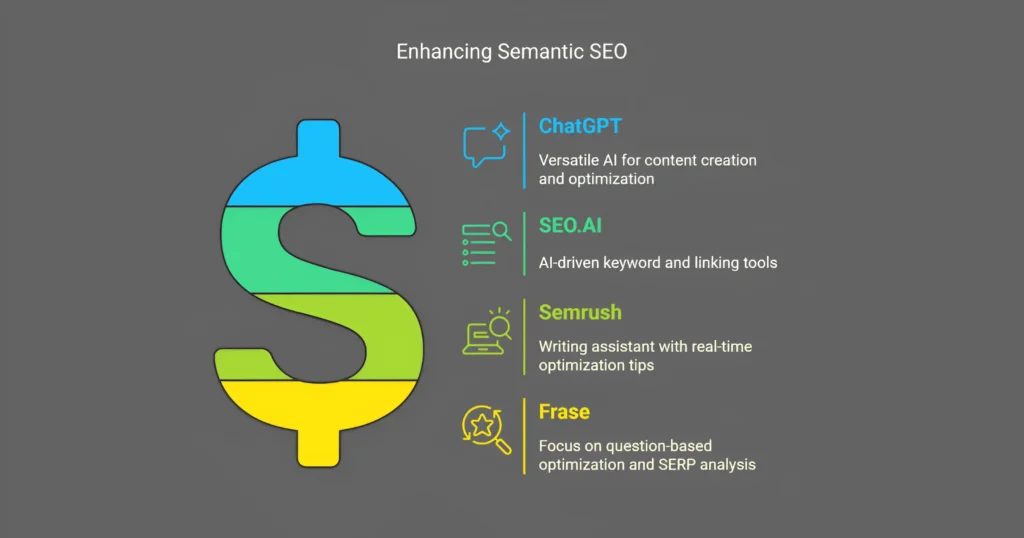
Boosting your blog’s semantic SEO doesn’t have to break the bank. Here are some of the best free AI tools that can help you create content that ranks higher and resonates with your audience:
1. ChatGPT
ChatGPT is a powerful AI tool that can handle various SEO tasks, from crafting title tags and meta descriptions to generating detailed content outlines. It’s great at analyzing search engine results and creating content that’s semantically optimized based on your input.
2. SEO.AI
SEO.AI offers free tools like an AI Keyword Tool and Paragraph Generator to optimize your content for semantic relevance. Its Internal Linking Tool also helps improve your blog’s structure by linking ideas naturally.
3. Semrush
Semrush’s free SEO Writing Assistant makes it easy to improve your content for semantic SEO. It gives you keyword suggestions, helps make your writing clearer, and offers real-time tips to optimize your blog posts.
4. Frase
Frase is your go-to tool for question-based optimization. It helps you discover relevant queries your audience is searching for and creates content that covers those topics comprehensively. Plus, its SERP analysis ensures your content addresses user intent.
These tools are fantastic for crafting high-quality, semantically optimized content without spending a penny. Give them a try and see how they can make your blogging strategy smarter and more effective.
Common Mistakes in Semantic SEO

- Keyword Stuffing: Overusing keywords hurts readability and rankings.
- Ignoring User Intent: Ensure every section answers real user questions effectively.
- Skipping Schema Markup: Without structured data, you miss out on rich snippets that boost click-through rates (CTR).
Conclusion
Semantic SEO is all about creating content that search engines can easily understand, not just stuffing in keywords. By focusing on meaning, context, and what your readers really want, you can improve your rankings and keep your audience interested.
Think of it as writing for people first while making sure search engines get the full picture too. Use topic clusters, link related ideas, and add structured data to make your content clear and helpful. Additionally, if you are into integrating AI into your workflow, you can check our step-by-step guide on “How to Use AI in Excel for Free in 2025“. or else you can read our latest blog on “How to Convert a Blog Post to Video with Lumen5 for Free“
Start using these tips today, and you’ll see your blog posts become more visible and valuable to your readers.
FAQs
Q1. What is Semantic SEO?
Semantic SEO makes your content meaningful and relevant by focusing on context, user intent, and topic coverage rather than just keywords.
Q2. Why is Semantic SEO important for rankings?
It helps you rank higher by creating content that connects with readers, improves user experience, and fully covers a topic.
Q3. How does Semantic SEO work?
It uses technologies like Natural Language Processing (NLP), knowledge graphs, and machine learning to understand content context and user behavior.
Q4. What’s the difference between Semantic SEO and traditional SEO?
Traditional SEO focuses on keywords and backlinks, while Semantic SEO emphasizes topics, user intent, and connected ideas for better relevance.
Q5. How can I perform semantic keyword research?
Use tools like Google’s “People Also Ask,” AnswerThePublic, or ChatGPT to find related terms and questions users search for.
Q6. What is a pillar page, and how does it help?
A pillar page is a detailed guide on a broad topic that links to related subtopics, improving internal linking and topic relevance.
Q7. How does schema markup improve visibility?
Schema markup helps search engines understand your content better and makes your pages eligible for rich snippets, increasing clicks.
Q8. What are the best free AI tools for Semantic SEO?
Tools like ChatGPT, Semrush Writing Assistant, Frase, and SEO.AI help with keyword research, content optimization, and question-based strategies.
Q9. What mistakes should I avoid in Semantic SEO?
Avoid keyword stuffing, ignoring user intent, and skipping schema markup to ensure readability and visibility.
Q10. How do I measure the success of my Semantic SEO strategy?
Track impressions, clicks, bounce rate, and time-on-page using Google Search Console; update content regularly to keep it relevant.

I was curious if you ever considered changing the layout of your website? Its very well written; I love what youve got to say. But maybe you could a little more in the way of content so people could connect with it better. Youve got an awful lot of text for only having 1 or two pictures. Maybe you could space it out better?
We will look forward to it